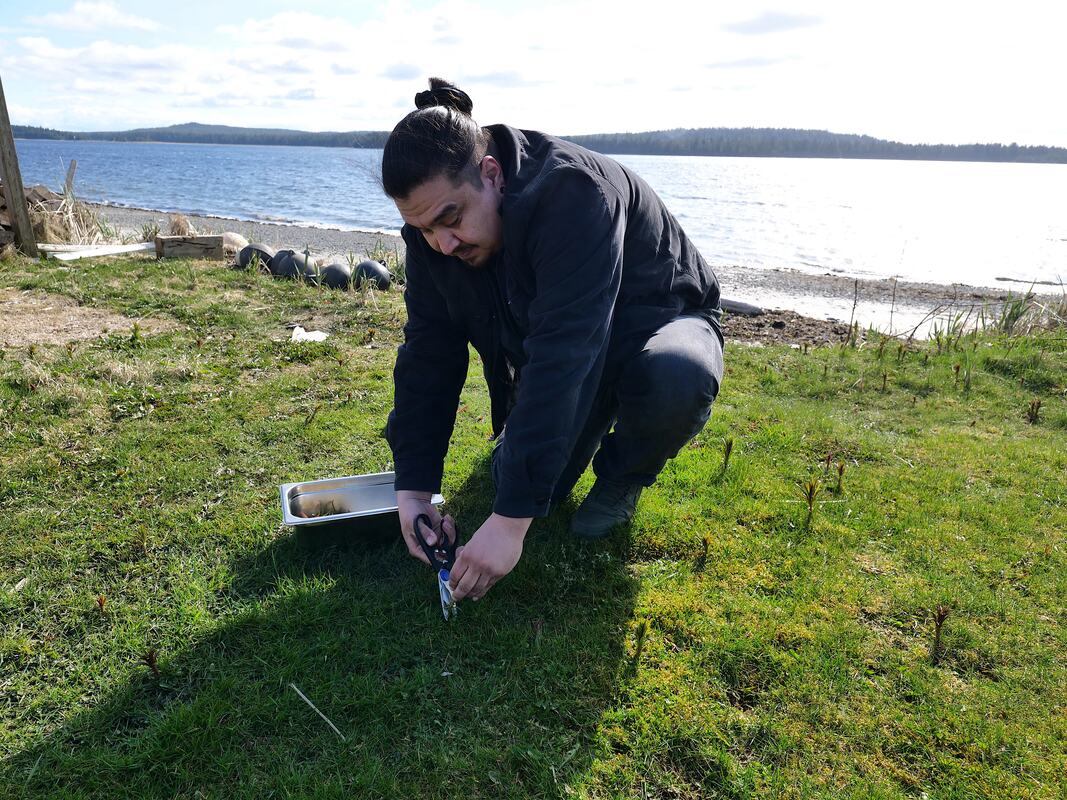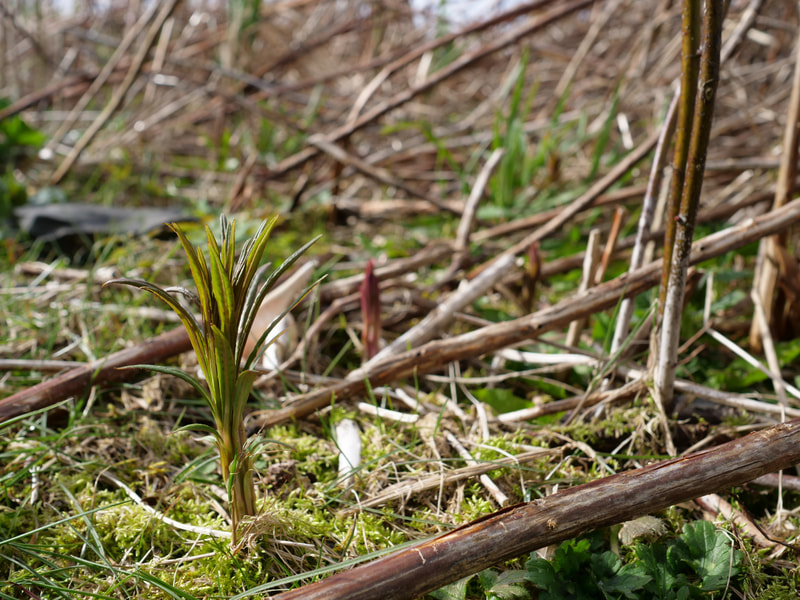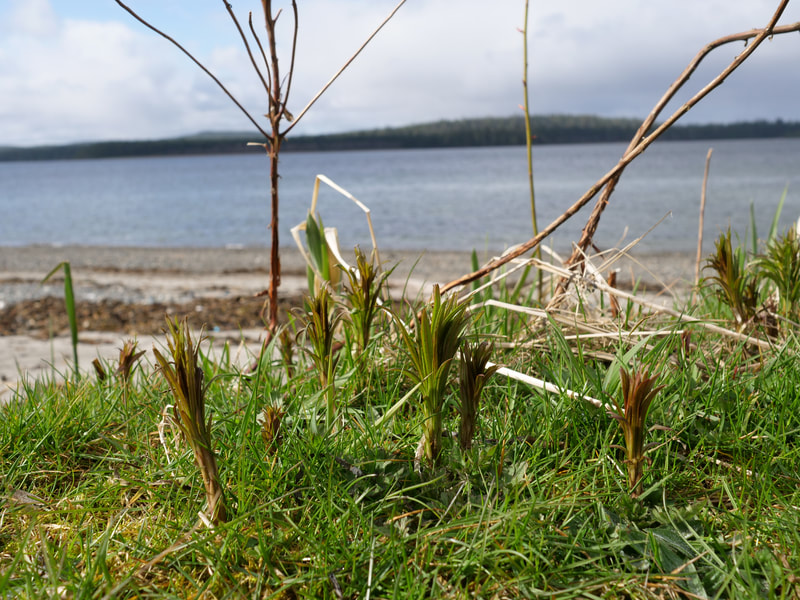|
There is a two to three week growing season for fireweed shoots in Haida Gwaii. Here at the intersection of Chef Brodie Swanson's front door, the Masset Inlet, and my curiosity, I’d arrived just in time to learn how to harvest and cook them. Just steps from the salty waters of the Masset Inlet knelt down on my knees, I’m getting a very hands-on lesson about harvesting and cooking this asparagus-like wild vegetable. Brodie Swanson, whose Haida name is Kil Tlaa'sgaa (strong voice) is a local chef I stumbled onto whilst hoping to learn about island cuisine. I’d sent him a message a few days earlier and to my pleasant surprise, he responded instantly! “Haaw’a (thank you in Haida) for reaching out. I’d be happy to chat. I’ll be available Tuesday afternoon, 3:30 pm” And, here we are on a Tuesday at 3:30 pm under the warmth of the only sunny day I saw during my week on this lush island rainforest. Welcomed like an old friend, Brodie had invited me to his home for a live, in-person cooking demonstration. We had only exchanged a couple of Instagram messages and yet I was soon standing in his kitchen learning about local food and culture, it was awesome! Brodie, a local Haida who is built like an island warrior with a barrel chest, broad shoulders, tattoos up both arms that reflect his heritage, and jet-black hair that goes nicely with his black-on-black attire. At first look, one might be a little intimidated. The intimidation factor quickly dissipates while I watch him kneel down on one knee with a pair of scissors, smiling while he delicately snips the heads of fireweed, making sure to leave the base to grow another flower. He notes the short growing season and how perfect it is that these vegetables grow right across the street from his house. A dozen or so headless fireweeds later we were headed inside, almost. He spotted a patch of freshly sprouted stinging nettles on the other side of a pile of logs and decided to grab a few bunches for something else he had in mind. The warning is in the name he says; It’s better to wear gloves when handling the nettles, though Brodie himself seems unfazed by their sting. Haida Gwaii (whose inhabitants date back thousands of years), have two distinct island clans, the Eagles and the Ravens. Brodie explains that his family belongs to the Ravens and en route to his house, I notice we are on Raven Road…how fitting I think to myself. Proud of his distinct roots, Kil (Brodie’s Haida name). later tells me his grandma was a Haida language teacher who was trying to preserve this endangered language. Kil guesses that less than 1% of the population can speak Haida fluently these days. In hopes of bringing that number up, he’s been taking language classes himself. The rich earthy terra and abundant waters of Haida Gwaii are an edible paradise where various seasons bring to life a number of plants, vegetables, and seafood ripe for harvesting. Brodie delightedly explains that when the tide is out, the table is set. Unlike a large part of the planet, the ground here has evolved without commercial farming and the use of pesticides and herbicides that typically come with it. For the most part, Haida Gwaii is as it has been since the dawn of time. It’s easy to find certified organic farms on the island. It’s this untampered soil that allows us to walk across the road from Brodie’s house to harvest the fireweed and nettles. Once harvested we head into the house. As we’re headed in, we pass a number of planter boxes that in the summer he grows other vegetables and some rose hips. The rose hips are left alone until the first frost ices over the berries in the fall, causing them to soften up and intensify their flavors. At that point he explains, they are perfect for making rose hip ketchup! The side door opens into a modified chef's kitchen. A stainless steel prep table makes up the island and we are surrounded by various sauté pans on one side and a wall of industrial-grade cooking supplies on the other. Shelves of large stainless steel pots, strainers, chafing dishes, knife sharpeners, tongs, and a brown canvas chef's apron. Everything you’d need to cater a party from 1 to 100! This wasn’t the type of home where you’d find an Air Fryer and Instant Pot. And if that wasn’t enough, to solidify his dedication to local cuisine, I was then greeted by two dogs, Zara, and Nettles. Yes, Brodie loves the plant so much that he named the dog Nettles🙂 Once inside, we quickly got down to culinary business! A pot of water and a couple of pans hit the stove, then some butter and spices begin to materialize. Brodie tells me we are making Brown Butter Fireweed Shoots and Nettle Goame. He explains the fireweed tastes like a mix of green bean and asparagus, making a great side dish. The nettles are hearty like kale but not quite as meaty and can be used in any dish where you would normally use spinach. Waiting for the water to warm, Brodie starts pulling out various jars and concoctions for me to smell and/or taste. A jar of elderberry passes under my nose while he informs me the little berries can be found all over the island and they make excellent vinaigrettes. Another jar makes its way from the fridge, this one is pickled sea asparagus from the inlet with garlic scapes grown in his planter boxes. One hits my lips and the vinegar puckers my face a little. It tastes like farmers' market dill pickles. Brodie tells me they are great for making tartar sauces and slaws. The water is just before boiling point and into it goes the nettles. He leaves them to cook for about a minute before transferring them into a cold water bath to save them from overcooking and turning gray. Next, a pinch of salt is added to the pot of water, and in go the fireweed shoots for the same treatment. Once cooled, the nettles are rinsed in cold water to remove any last bits of potential dirt. They are then spun in a salad spinner before being squeezed out in a paper towel to get them as dry as possible. After the squeeze-dry treatment, the white paper towel looks like a faded tie-dye t-shirt! The stems of the nettles are removed and a mortar and pestle appear on the stainless prep table. Some toasted sesame seeds are then ground down before the chef adds in soya, saki, mirin, rice vinegar, and a touch of salt. Everything is further muddled to create this Japanese dressing before it’s tossed in with the nettles. As expected, the dish is both unique and intriguing, much like the island and the man behind the mortar. Next, the fireweed shoots are given the same rinse and spin treatment that the nettles were. Meanwhile, the butter simmers in a pan and once it has turned into a rich nutty brown color the shoots are thrown in. With a light sauté and a few fancy mid-air flips, Chef Brodie then adds a splash of apple cider vinegar and lets it simmer away before adding a final pinch of salt. In a few short minutes, the dish is ready and delicately presented in a small serving dish as though it were one of the courses of an eight-course tasting menu. Allowing the dish to cool briefly, Brodie and I sample it. The fatty warm taste of the butter quickly coats the inside of my mouth before the salt flares my tastebuds. The dish is rich and delicious, something that would go well atop a medium-rare porterhouse. Not far off from my assumption, he says that as well as a side dish, he likes to use this as a layer in a venison sandwich. I’m thinking that might be a good way to use up a few of the two hundred thousand black-tailed deer that overpopulate the islands. As the cooking class closes we get to chatting about Brodie's life, local foods, and life on Haida Gwaii. As a kid on an island with limited outside influence, he’d get his culinary inspiration from T.V. or from cookbooks. Not being able to go out to your typical mainland restaurants, he’d try to recreate the dishes he had seen or read about at home with what was available to him. He said his family didn’t cook like this, but they often canned and preserved foods throughout the different growing seasons. Brodie is the former executive chef for Haida Tourism; he’s done some freelance catering and did a previous stint in Vancouver where he became heavily influenced by Japanese cooking under one of his mentors, Nathan Lowey of Dosanko. Hence the “Japanese Gomae”. These days he prefers to cook for friends, family, and for some of the Island’s Potlatch events. A ceremonial feast that was suppressed during colonialism where locals would get together to display wealth & prestige. The in-house cooking demonstration under the watchful eye of Zara and Nettles was just one more example of the hospitality of the Haida people I came across and my personal chef for the afternoon was the ideal advocate for the job. However, it's when the conversation shifted from tastes to totems that he really lit up. Totem poles are another proud marker of the locals, which nearly became erased from history under the suppression and dark days of colonial religion, politics, and whitewashing. In 1969 local Haida artist Robert Davidson decided to break a nearly 100-year-old gap in the tradition of pole carving on the island. His courage sparked a much-needed reboot of locally celebrated culture. Brodie proudly explains there are now nineteen poles around Masset and even more spread across the archipelago, a symbol of the locals' strength and resilience. The dishes were simple yet thoughtful, the afternoon was intimate and informative, and the setting was welcoming and inspiring. A reflection of Haida Gwaii as a whole. Imagine a world where you can survive off of what is harvested in your own backyard, and your front door is a welcome symbol for friends you haven’t even met yet. Recipes: Nettle Gomae: Gomae is a traditional Japanese salad typically made with spinach. This recipe will yield enough for roughly one side dish. Tools required: * Mortar & pestle * Salad spinner * Sauté pan * Measuring spoons * Pot for blanching half full of water * Paper towel (white is more fun to see the color from the nettles after) * Small whisk Ingredients: The ingredients will all work together to balance out the overall taste. The sesame will help add to the nutty flavor of the dish, the sweetness of the mirin will help to balance out the bitterness of the nettle and the pinch of salt at the end will help to enhance the overall flavors. * 1 cup fresh nettles (careful they sting!) * A few pinches of salt * 2 tbsp of mixed, toasted sesame seeds * 2 tsp of soya sauce * Cap full of saki (1 tsp +/-) * 2 capfuls (2 tsp) of Mirin - Mirin is a sweet Japanese rice wine. * Teaspoon of rice vinegar Instructions: Rinse fresh nettle under cold water - you may want to use gloves for picking up and handling prior to blanching as “stinging nettles” tend to live up to their name. * 4-6 heads (roughly 1 cup dry on the stem) of nettles blanched for one minute in rolling but not boiling water. Then remove and place in a cold water bath immediately otherwise the nettle will turn gray. Let stand in cool water for several minutes then remove. Rinse under cold water then spin in a salad spinner until damp. The rinse and spin will help remove any dirt that may have been on them. * Remove stems, then place nettle leaves in a paper towel and squeeze out excess moisture. The color from the nettels will come off on the white paper towel showing shades of purple, green, and blue. A sort of culinary tie-dye. * In the mortar and pestle add the 2 tbsp of toasted, black and white sesame seeds (or white if that’s all you’ve got) and muddle to a coarse grind. * Then add in 2 tsp of soya sauce, a cap full of saki (1 tsp +/-), 2 capfuls (2 tsp) Mirin, and a teaspoon of rice vinegar. * Mix together all ingredients except the Nettles with a small whisk or spoon to make a thick dressing. * In a small bowl add the nettles then spoon roughly 1 tsp of the mixture and lightly toss with a spoon. Then add another tsp and toss with a spoon. Add a pinch of salt to enhance the flavors and enjoy! Brown Butter Fireweed Shoots Typically as a side dish served with red meats or added to something like a nice venison sandwich. Tools required: * Pot for blanching half full of salted water Ingredients: * 6-8 heads of fireweed (pre-flower) * 1 TBSP of butter * 1 TSP apple cider vinegar * Pinch of salt Instructions: * Rinse fireweed under cold water to remove excess dirt. * Place fireweed blanched in rolling but not boiling salted water (tsp of salt) for a minute. Then remove and place in a cold water bath for several minutes. Remove, rinse under water, and spin in a salad spinner until most of the moisture has dissipated. This will also help remove any hidden dirt that may have been on them. * Bring a tbsp of butter to a simmer over medium heat until the color turns to a nutty brown shade. Then toss fireweed into the mix. Add half a cap full (1 TSP +/- ) of apple cider vinegar into the pan while cooking. Sprinkle with a pinch of salt. Remove from the pan and plate appropriately as a side dish. The earthy flavors work well with red meats and will make an excellent addition to a venison sandwich, like those made from the abundance of black-tailed deer running around Haida Gwaii.
0 Comments
Leave a Reply. |
Copyright © 2023 KIXMARSHALL.COM









